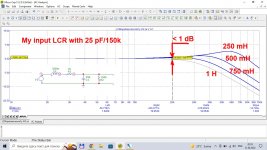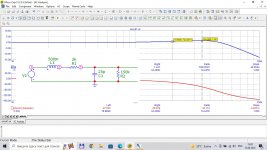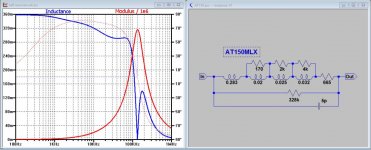we can say you changed the usual mm cartridge resonance range then damped with overall results being the higher SNR?
Yes we can, and not only better SNR but also better real freq response at HF for almost any MM cartridge (i.e. with any inductance) and without any adjustment like C-matching while test-LP playing. See the attached two screenshots where cartridge inductance is stepped 250-500-750-1000 mH but one with mine "Aperiodic" low input capacitance and 150k, and other is standard 150 pF and 47k. I have less than 1 dB negligible delta @ 20 kHz and standard is 12 dB unaccepatable delta.
Are we struggle for "setup" or for a good sound? I have not any problem to insert my preamp inside any turntable, bit I have made a good sound for it. And thanks to such a construction I have only 5...7 pF capacitance of the wirings inside tonearm (plus approximately 20 pF of LSK389, total 25 pF). Isn`t it a reason for MC sound from MM cartridges?I can believe something like that , but then we can't use your preamplifier in a normal setup using cables between the tonearm and the preamplifier as 1m of the best cables cables present well over 50pF of capacitance.
Attachments
As I know K157XP3 is a SU a dynamic noise filter (like Philips DNL but with much better sound), I have a dozen of such IC in my flat in Kiyv and can send it for you, but only after I return to Kyiv after war is over. Please send me your address to my email (it mus be seen in my diyaudio.com profile) and I will. PS. I worked for more than 30 years at the Kiev Research Institute of Electromechanical Instruments - the USSR's leading enterprise for magnetic recording, we developed and certified many household tape recorders, and also developed special tape recorders, including those that flew into space with Gagarin. You can watch dozens of my documentaries about it on my YouTube channel here: https://www.youtube.com/playlist?list=PLu1Wtw8bW_xiixdo1fawGVigrWO0pexb3I have read a romanian article refferencing to 1987 Radio article, even bought 2 cassette players having those bias chips yet never used them.
Also found a Karat MP_202C double deck which i was impressed of,(i know there are better decks than this...) but it's defective (probably thr regulator section ...and wjo knows what rlse?) and I couldn't find a schematic for it.Could you help me with that so that i can give it a new life? It has these chips whic look like some sort of dolby processing but no clear ideea: https://kiloom.ru/spravochnik-radiodetalej/microsxema/k157xp3-ka157xp3.html
I use standard IEC equivalent of MM = 500 mH in series with 1 kOhm. For testing I use stepping of inductance from 250 mH to 1 HWhat model have you used for the cartridge generator? I have found that manufacturer specs are woefully inadequate (and commercial MM designers don't seem to have considered loading properly for about 30 years 🙂 )
150 kOhm is not too much. It is enough for a good damping if you have low input capacitance. See the attached screenshot or even test my circuit file [ freely here https://www.patreon.com/posts/68010671 ] in Microcap 12 circuit simulator [ also freely here http://www.spectrum-soft.com/index.shtm ]Isn't 150k too much? If the load resistor is smaller, the damping of the resonance is better, and the 1/f noise is lower. I would try 10k instead of the usual 47k.
And you are wrong with resistor noise: if input resistor is smaller, it`s current noise is bigger. As input resistor is paralleled with cartridge, we must summarize not noise voltages but noise currents.
Attachments
Here I find kind of irrelevant information.Very few people are able to hear the high frequency level any cartridge can get out of a vinyl with the most modest phono preamplifier.I'd add HF content to SNR as irrelevant factors for a phono preamp quality if this wouldn't actually be a malign factor when dealing with usual vinyl's wear or dust generating transients. We don't really need more high frequency transients to fight with.The original RIAA standard already dealt with the frequency response , the only improvement being made by EMT which made RIAA filter variable in a small range of frequencies. I worked on a similar design to EMT's back in 2018 obtaining really good results on dealing with different vinyls.R23 and R25 are actually the both sides of a wirewound potentiometer:Yes we can, and not only better SNR but also better real freq response at HF for almost any MM cartridge (i.e. with any inductance) and without any adjustment like C-matching while test-LP playing. See the attached two screenshots where cartridge inductance is stepped 250-500-750-1000 mH but one with mine "Aperiodic" low input capacitance and 150k, and other is standard 150 pF and 47k. I have less than 1 dB negligible delta @ 20 kHz and standard is 12 dB unaccepatable delta.
Are we struggle for "setup" or for a good sound? I have not any problem to insert my preamp inside any turntable, bit I have made a good sound for it. And thanks to such a construction I have only 5...7 pF capacitance of the wirings inside tonearm (plus approximately 20 pF of LSK389, total 25 pF). Isn`t it a reason for MC sound from MM cartridges?
https://www.diyaudio.com/community/threads/1v2-phono-riaa-preamplifier.315824/#post-5269451
The noise was a problem due to playing around the Miller plateau and large valued resistors , but I got my lessons there and found some of the most valuable concepts around vinyl reproduction. Very linear base reproduction isn't desirable either as you need to fight rumble and tonearm resonances too while most speakers can't deal properly with high contents of lows either so I always cut the frequency response in the low frequency region too.You'll find that done on very expensive 10k $ Chord dacs too not just on analogue phono preamps.
The most important quality of a phono preamp I find is its behavior at high input signals, the input and output saturation region. Kenwood was the best at this game in the solid state arena.Tubes are way potent than any silicon design in this respect and I know what I'm talking about cause I built phono preamps in all technologies. I saw you're using ksa1381 and its complement for the output and that helps a bit with their inherent quasi saturation behavior, but other than that the original kenwood circuit was on the low end spectrum for controlling transients.Kenwood made both very simple and monster phono preamps. According to Kenwood l-02A specs, its finest details and its very few reviews I got over the time it seems to me to be the best phono preamp ever made and I'm pretty sure it's impossible to beat it in silicon technology.I said that for a few times already, but that preamp gave me a very different take on the whole phono reproduction philosophy as we can't really discuss it without the whole audio chain compression factor and this phono preamp was inside one of the best 170 watts siliconpower amp ever made too. Some other people have their different prefferences...I can't fight tastes. Bill's using software compression to listen to vinyls as clean as possible , I like hard analogue techniques yet i couldn't find anything being able to beat tube preamplifiers in the phono reproduction.I even reproduced the luxman cl34 which was the only active feedback design i found to be on par with passive riaa, but then I realized that passive solutions actually have an edge in the SNR department over the active tube designs which was counterintuitive yet passive designs are very imune to hum , EMI and oscillations perceived as noise. Having a very objective approach to vinyl environement which usually include more noise sources than simulations can think of is a bit better than just obtaining pure numbers.
Then introducing the phono preamp inside a turntable is a big problem for many turntables as either the motor or the strobe or motor drive circuitry are inducing all sort of noises in their proximity. The usual 1.5... 2 metter cable's capacitance connecting the turntable to the phono preamp also takes down some good EMI.
And not everyone got sucked into mc carts hype which create more problems than they are able to solve.HF content up to 100kz as mc carts can reproduce are thrill killers if not damped properly. I'd never indulge into making MM carts sound like MC carts.
As promised a measurement of a cartridge using a VNA done by Hans Polak working with Gpapag. Interesting part is that electrically its less than 0.5dB down at 20kHz with 150pF||47k. No need for any mechanical pick me up from the stylus, and none visible in a frequency sweep with a credible test source.
Attachments
Unfortunately i found Hans's model for shure v15 type 3 unable to give a linear response when introduced in a highly linear phono preamp simulation.It appears that he modified the riaa curve to accomodate its shure model.I hope he did better models for other carts.
I bet you remember this topic though 🙂Hans never measured a V15-III you probably mean George.
https://www.diyaudio.com/community/threads/fet-vs-bjt-input-phono-preamp.357649/page-22#post-6371931
And this one:
https://www.diyaudio.com/community/threads/riaa-preamps-versus-real-loads.361600/
And maybe this post?!....
https://www.diyaudio.com/community/threads/riaa-preamps-versus-real-loads.361600/page-7#post-6424248
Last edited:
Really!?No I don't remember that first topic and have little to no memory of the others.
Last edited:
I re-read and yes you were a total idiot which is when I decided to pay little attention to threads you start. Your postings on this thread have reminded me. You are not interested in a co-operative discussion.
....I re-read and yes you were a total idiot which is when I decided to pay little attention to threads you start. Your postings on this thread have reminded me. You are not interested in a co-operative discussion.
Well...I gave you proof of Hans models for Shure v15type 3. Whether they are measured or just invented was a matter of debate until I have shawn that his model can't give a linear response with National Semiconductor's choice of anti-riaa and riaa network found in LME49710 datasheet.Those same networks were used by Patrick Turner ,Andrea Ciufolli and myself and allowed me to pass 25khz square wave through a phono preamp.I re-read and yes you were a total idiot which is when I decided to pay little attention to threads you start. Your postings on this thread have reminded me. You are not interested in a co-operative discussion.
Then that topic stopped and was abandoned as any topic where well known personalities of this forum can't admit to a "nobody" they did something wrong.
What sort of co-operation are you looking for? Just let me know! Make it worth my time and my money please!

How about we cut out the character analysis and other rule breaking actions and return to topic?
My hockey stick is kinda dusty and needs a couple slapshots to get me back in the game. Who wants to be first?
How about cartridges with an inductance of the order of 500 mH and a recommended load capacitance of the order of 400 pF? They must have a considerable mechanical resonance and considerable electrical losses to get a reasonable response with their recommended load. Attempts to flatten the electrical response can then worsen the overall response.As promised a measurement of a cartridge using a VNA done by Hans Polak working with Gpapag. Interesting part is that electrically its less than 0.5dB down at 20kHz with 150pF||47k. No need for any mechanical pick me up from the stylus, and none visible in a frequency sweep with a credible test source.
Richard Visee measured the impedance of a Shure V15-III decades ago, but not the mechanical response. The results are in my article in Electronics World October 2003.
Damn...I wish I had access to these sources 20 years ago...Richard Visee measured the impedance of a Shure V15-III decades ago, but not the mechanical response. The results are in my article in Electronics World October 2003.
Attachments
-
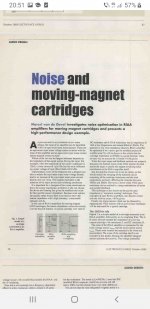 Screenshot_20220622-205128_Word.jpg222.1 KB · Views: 386
Screenshot_20220622-205128_Word.jpg222.1 KB · Views: 386 -
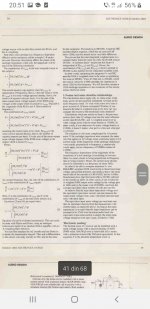 Screenshot_20220622-205135_Word.jpg259.2 KB · Views: 381
Screenshot_20220622-205135_Word.jpg259.2 KB · Views: 381 -
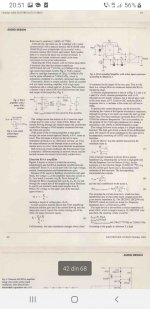 Screenshot_20220622-205143_Word.jpg251 KB · Views: 479
Screenshot_20220622-205143_Word.jpg251 KB · Views: 479 -
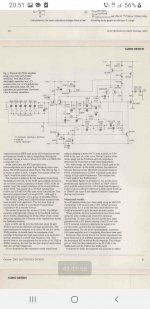 Screenshot_20220622-205152_Word.jpg235.1 KB · Views: 494
Screenshot_20220622-205152_Word.jpg235.1 KB · Views: 494 -
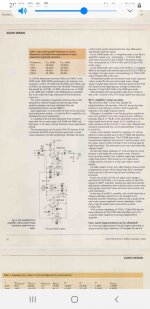 Screenshot_20220622-205202_Word.jpg239.4 KB · Views: 489
Screenshot_20220622-205202_Word.jpg239.4 KB · Views: 489 -
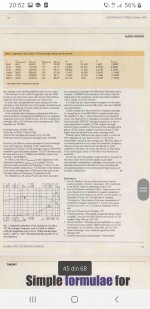 Screenshot_20220622-205212_Word.jpg247.4 KB · Views: 395
Screenshot_20220622-205212_Word.jpg247.4 KB · Views: 395
The purely mechanical frequency response of a cartridge is not constant and deteriorates at high frequencies as it moves from the outer grooves of the record to the inner grooves. Meanwhile, the grooves of test records for measuring the frequency response are recorded only on the outer grooves. Therefore, such measurements cannot be recognized as corresponding to reality. In the spectral analysis of real musical records, I cannot find any components with frequencies above 14-15 kHz on the inner grooves, while components even above 20 kHz are clearly observed on the outer grooves of the same musical group with the same composition of musical instruments. This is about the same as magnetic playback of 9.53 cm/s reel-to-reel tape recorders with a playback amplifier for 19.05 cm/sRichard Visee measured the impedance of a Shure V15-III decades ago, but not the mechanical response
That's the transfer from record to stylus, but according to some articles Hans van Maanen wrote in the 1970's, there is also a mass-spring like second order mechanical low-pass from stylus to magnet, usually with Q > 1/2 sqrt(2). He claimed this mass-spring response and the electrical response are designed to together have a more or less flat response, similar to a fourth-order Chebyshev. He proposed damping the electrical response and using an inverse resonance filter to replace the mass-spring response with something better damped. Decades later, Steven van Raalte wrote an article about an improved version.
@billshurv is trying to measure these things on cartridges. The first cartridge he tried has a nearly flat electrical response and must therefore have a well-damped mass-spring response, as the response with a test record is also good.
@billshurv is trying to measure these things on cartridges. The first cartridge he tried has a nearly flat electrical response and must therefore have a well-damped mass-spring response, as the response with a test record is also good.
- Home
- Vendor's Bazaar
- Nick Sukhov SU-XXI MM Phono stage -85 dBA SN ratio...

